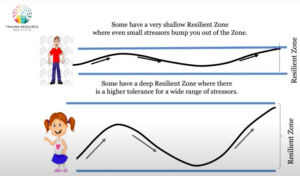This week, I was mostly researching trauma-informed care and learning about Adverse Childhood Experiences (ACEs). Through this research, I felt like I was really understanding how I wanted to expand the PASTA curriculum to youth. Through the Trauma Resource Institute’s webinar on cultivating our best selves in response to the pandemic, I especially enjoyed the idea of resilient zones and resiliency pauses. Resiliency pauses allow individuals to ground themselves and remind themselves of their resources and strength. The Resilient Zone provides a way to comprehend feelings and triggers to stressful events. For the curriculum, I hope to use the model to help the youth understand their feelings and widen their resiliency zones. Additionally, in Michael Ungar’s “Put Down the Self-help Books: Resilience is not a DIY Endeavor,” he emphasized that resilience is not solely something that can be found within oneself. It is easier to be resilient when the services and communities around us are supportive. I thus hope to underscore that youth are not on their own, and that reaching out for help is a source of strength, not weakness.


